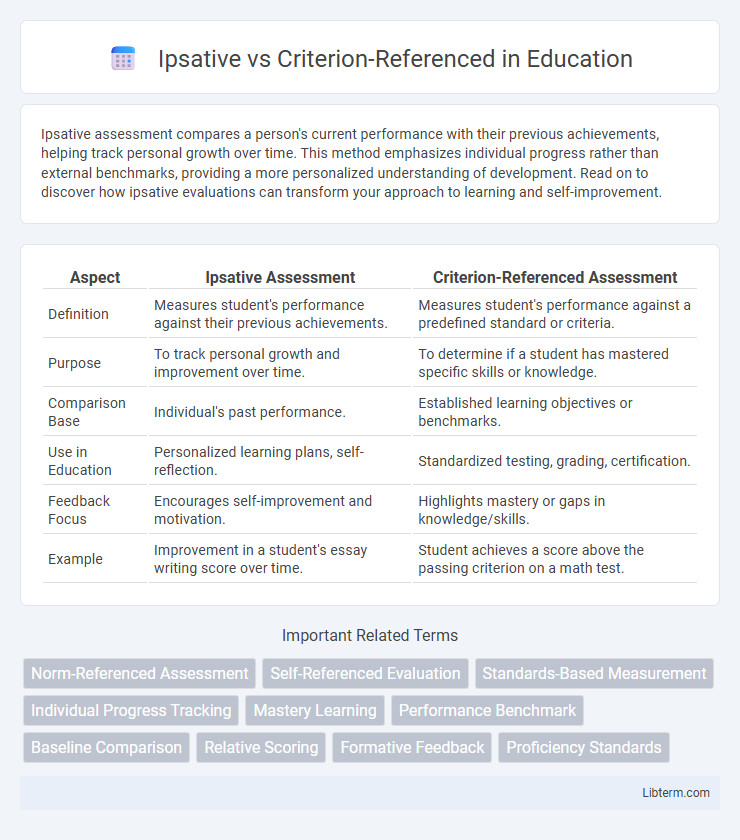Ipsative assessment compares a person's current performance with their previous achievements, helping track personal growth over time. This method emphasizes individual progress rather than external benchmarks, providing a more personalized understanding of development. Read on to discover how ipsative evaluations can transform your approach to learning and self-improvement.
Table of Comparison
| Aspect | Ipsative Assessment | Criterion-Referenced Assessment |
|---|---|---|
| Definition | Measures student's performance against their previous achievements. | Measures student's performance against a predefined standard or criteria. |
| Purpose | To track personal growth and improvement over time. | To determine if a student has mastered specific skills or knowledge. |
| Comparison Base | Individual's past performance. | Established learning objectives or benchmarks. |
| Use in Education | Personalized learning plans, self-reflection. | Standardized testing, grading, certification. |
| Feedback Focus | Encourages self-improvement and motivation. | Highlights mastery or gaps in knowledge/skills. |
| Example | Improvement in a student's essay writing score over time. | Student achieves a score above the passing criterion on a math test. |
Introduction to Assessment Types
Ipsative assessment evaluates an individual's performance by comparing current results with their previous achievements, emphasizing personal progress and self-improvement. Criterion-referenced assessment measures a learner's performance against predefined standards or learning objectives, determining whether specific skills or knowledge have been mastered. These assessment types serve different educational purposes: ipsative fosters motivation through individualized growth tracking, while criterion-referenced provides clear benchmarks for competence evaluation.
Defining Ipsative Assessment
Ipsative assessment measures an individual's performance against their previous results, highlighting personal growth and progress rather than comparing to external standards. Unlike criterion-referenced assessment, which evaluates performance based on predefined criteria or learning objectives, ipsative assessment emphasizes self-improvement and individualized learning paths. This approach supports personalized education by tracking changes within the same learner over time.
Defining Criterion-Referenced Assessment
Criterion-referenced assessment measures a learner's performance against a fixed set of standards or learning objectives, rather than comparing it to the performance of peers as in ipsative assessment. It determines whether specific skills or knowledge have been acquired, providing clear benchmarks for mastery and individualized feedback. This type of assessment is commonly used in educational testing, certification programs, and skill evaluations to ensure that predetermined criteria are met.
Key Differences Between Ipsative and Criterion-Referenced
Ipsative assessment compares an individual's performance against their previous results, emphasizing personal progress instead of external standards, while criterion-referenced assessment measures performance against fixed benchmarks or learning objectives. Ipsative evaluations foster self-improvement by highlighting growth, whereas criterion-referenced assessments determine whether specific criteria or competencies are met. The key difference lies in ipsative focusing on intra-individual change and criterion-referenced targeting predefined external standards for mastery.
Advantages of Ipsative Assessment
Ipsative assessment offers personalized feedback by comparing a student's current performance with their previous achievements, promoting continuous self-improvement and intrinsic motivation. It reduces external competition and stress, fostering a growth mindset and encouraging learners to focus on their unique progress. This approach supports individualized learning paths and helps educators tailor instruction to meet specific student needs effectively.
Benefits of Criterion-Referenced Assessment
Criterion-referenced assessments provide clear benchmarks that measure student performance against predefined learning standards, ensuring objective evaluation and targeted feedback. This approach supports personalized learning paths by identifying specific skill gaps and enabling educators to tailor instruction effectively. Unlike ipsative assessments that compare students to their previous performances, criterion-referenced assessments drive mastery of essential competencies crucial for academic and professional success.
Ideal Use Cases for Ipsative Assessment
Ipsative assessment is ideal for tracking personal progress over time by comparing an individual's current performance against their previous achievements, promoting self-improvement and motivation. It suits contexts like personalized learning plans, skill development programs, and coaching where growth is measured relative to one's own standards rather than external benchmarks. Unlike criterion-referenced assessments, ipsative methods emphasize internal growth, making them valuable in settings focused on continuous personal development.
When to Use Criterion-Referenced Assessment
Criterion-referenced assessment is most effective when the goal is to measure a student's performance against a specific set of learning standards or objectives, allowing educators to determine whether each learner meets predetermined criteria. This type of assessment is commonly used in mastery learning, certification processes, and skill competency evaluations, where individual achievement is prioritized over relative performance. Criterion-referenced tests provide clear, actionable insights into student progress and instructional effectiveness by highlighting areas that meet or fall short of defined benchmarks.
Challenges and Limitations of Each Approach
Ipsative assessments face challenges such as limited comparability between individuals because results reflect personal progress rather than external standards, which restricts their use in making normative judgments. Criterion-referenced assessments, while offering clear benchmarks for performance, may struggle with setting appropriate difficulty levels and may not account for individual learning differences, limiting their ability to fully capture a learner's capabilities. Both approaches require careful implementation to balance meaningful feedback and valid evaluation, highlighting the need to consider context and purpose when selecting the assessment method.
Choosing the Right Assessment Method
Choosing the right assessment method depends on the purpose of measurement; ipsative assessments compare an individual's current performance to their past results, highlighting personal growth and self-improvement, while criterion-referenced assessments evaluate performance against fixed standards or learning objectives to determine mastery. Ipsative methods are ideal for tracking progress in skill development or behavioral interventions, whereas criterion-referenced assessments suit contexts such as certification exams or competency evaluations where meeting predefined criteria is essential. Understanding the goals and context ensures selection of an assessment that provides meaningful and actionable insights aligned with educational or organizational objectives.
Ipsative Infographic

 libterm.com
libterm.com